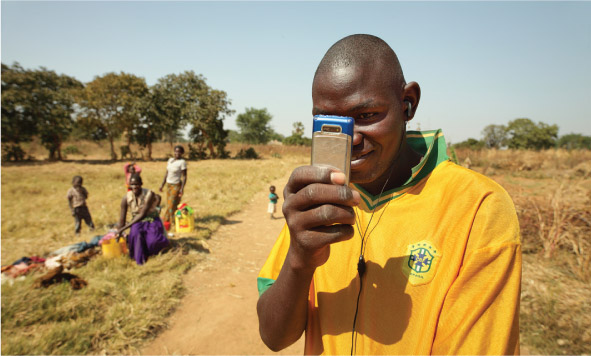8.3 The rise of mobile phones
In recent years the increasing use of mobile technology and social media has changed the way people use the internet, which has implications for low- and middle-income countries.
Source 8.10a Mobile usage in Africa (02:59)
Vodafone and Oxfam International are examples of a business and a non-government organisation working collaboratively to reduce the impacts of rural poverty. Mobile phones can play a role in this by helping overcome infrastructure barriers. For example, mobile technologies can give isolated and poor farmers access to information and to services, such as micro-banking and insurance.
One example is the Kenyan Farmers Helpline, known locally as Huduma Kwa Wakulima, which allows farmers to access assistance for immediate issues, such as weather information and pest control. M-Farm is another example: it allows farmers in Kenya to buy and sell their produce or obtain information about market prices via their mobile phones. The introduction of solar-powered recharge devices has reduced the need to walk (sometimes long distances) to a power source, but the rate of change in technology, compatibility issues and affordability are still problems.
A recent report relating to mobile phone use and gender in low- and middle-income countries by the GSMA (Global System for Mobile Communications Association) revealed the following data in 2010:
- Males are 21% more likely than women to own a mobile phone.
- Women in rural areas are 23% less likely to own a mobile phone than women in urban areas.
- There are estimates of US$13 billion in future business opportunities in these countries.

Source 8.11 Using a mobile phone to take photographs in rural Zambia - Women are two-thirds of the potential market for mobile phones in the next 5 years.
- Ninety per cent of women feel safer when they have a mobile phone.
Socio-cultural factors are significant when seeking to explore the gender gap in mobile phone use and ownership: the traditional role of women, rural living, education and income levels all make a contribution. Also, the introduction of any new technology needs to include respect for cultural differences. For example, an online database may be useful to record health details of people living in rural communities, but inconsistencies with data may arise if a person’s date of birth is given as ‘the day of the torrential rains’.
Mobile technology – issues for consideration
The following are some of the challenges for the future:
- lack of computers and equipment
- difficulty of teaching skills needed to make effective use of equipment in terms of accessing and evaluating information
- lack of teachers with ICT skills
- breakdowns and maintenance of devices, software and network connections
- lack of electricity and other infrastructure
- cost of computers, mobile phones and internet connection
- theft of equipment
- cyberbullying and other forms of anti-social or criminal behaviour on the internet, such as viruses and scams.
- inadequate personal skills to make effective use of equipment in terms of accessing and evaluating information.
The World Bank reported in 2009 that there was a 1.3% increase in economic growth for every 10% increase in broadband internet connection.
DEVELOPING YOUR UNDERSTANDING 8.5
- Investigate the access, cost and use of mobile phones in the poorer regions of Nairobi (Kenya) or Mumbai (India). Present a written report, using subheadings to organise your findings.
- Take action! It is estimated that there are 22 million disused mobile phones in Australia alone. Organisations such as Mobile Musters (go to www.cambridge.edu.au/hass9weblinks and follow the link to the website) provide opportunities for mobile phone recycling. Investigate the environmental costs of unrecycled electronic waste (e-waste). Create a poster for a campaign to recycle mobile phones in your school or local community. Include in the poster the environmental costs of unrecycled e-waste in Australia.